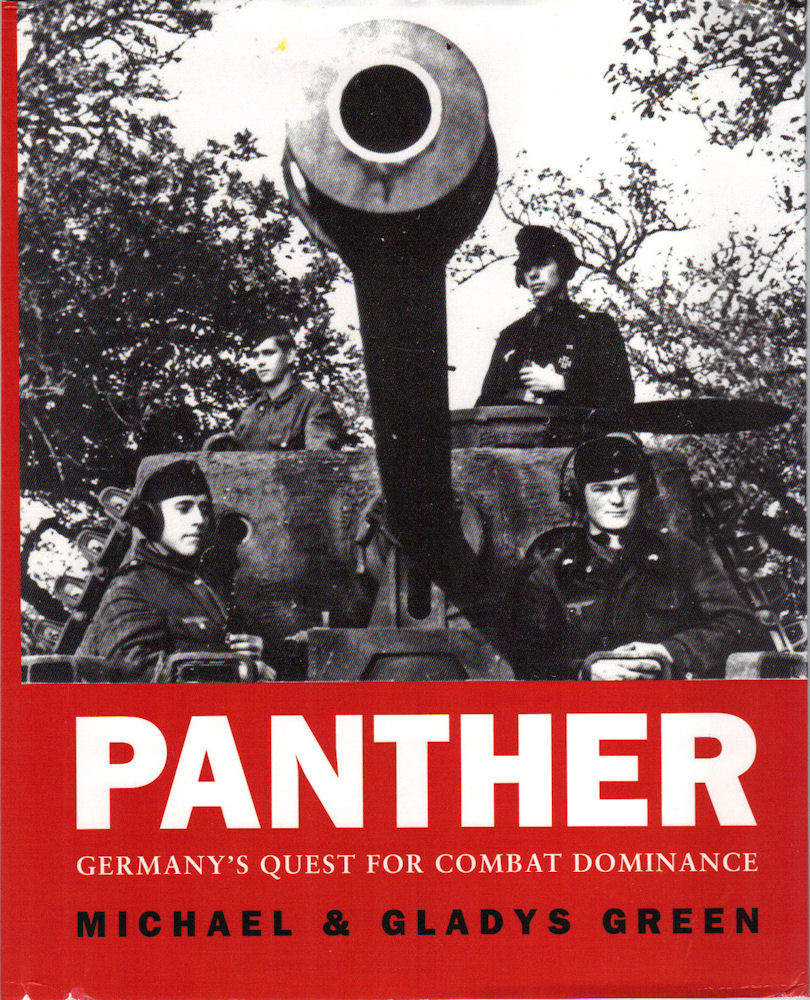Panther: Germany's Quest for Combat Dominance
The Greens have written a detailed, very readable account of the Panther tank (Panzerkampfwagen V, Ausfuhrüng D). Michael Green has first-hand knowledge of the Panther, as he was a member of the team that restored a Panther A, now part of the late Jacques Littlefield's collection in Portola Valley, CA. I'm not an armor buff myself but found the book easy to read and understand. The book is well written, and both armor buffs and modelers can each take away all the detail or general info they desire. The book provides color photos of restored tanks' interior and exteriors, and WWII black & white photos of operating and knocked-out tanks. Best of all, the Greens provide first-hand accounts of the Panther's effectiveness in battle from official British and US reports, as well as eyewitness accounts of the Panther in battle.
Background:
The Panther's predecessors, the Panzer III and IV, which dominated Western Europe battlefields through 1940, were clearly outmatched by T-34 Soviet tanks during Barbarossa. By November 1941, directives were issued for a better armored, higher firepower (75mm), new medium tank with a sloping glacis plate. The bureaucratic infighting between MAN and Daimler Benz, and the rush to employ the new tank, inevitably led to major operational problems in-theater. Nevertheless, the German Army now had a medium tank that could meet and outperform its rivals, the T-34 and the American Sherman tanks. Debuting in July 1943’s Operation Zitadelle, the Panther proved to be disappointing, largely due to mechanical breakdowns and lack of crew training. However, the lethality of its 75mm main gun was a major positive attribute, knocking out 263 KV-1 heavy tanks at long range. The A and G models followed in late 1943-1944. The authors also provide interesting sidebars, such as a discussion of "Disguised Panther Tanks" – Panthers adapted to resemble M10 tank destroyers during the Battle of the Bulge.
Firepower:
As the authors make clear, German armor strategy changed completely with the Panther. Previously, German tanks were "valued for mobility first, firepower second, and protection third." After the invasion of Russia, priorities were rearranged: "Firepower became first, protection second, and mobility last." Thus follows an in-depth discussion of the Panther's ammunition and all variants, storage, optics, turret, and most importantly the 75mm main gun. There are many interior and exterior detail photos, right down to the gunner's foot pedals utilized to traverse the tank's turret. Wartime reports by the British and US, and an account of Panther vs. Sherman action in Herrlisheim in January 1945, provide eyewitness corroboration of the subject.
Protection:
The sloped armor of the Panther both deflected incoming projectiles and increased armor thickness due to the geometry of the slope. Allied accounts, especially US and British accounts, uniformly note the difficulty of damaging the Panther in a frontal attack. A March 1945 US Army report notes, "You always have to hit them in the side or rear compartment." The authors provide sections on the US, British, and Soviet armies’ responses, including an American account of a Panther captured in Normandy, moved to a suitable location, and fired at with "every weapon available, including rifle grenades, 40mm antiaircraft guns, and 105mm howitzers. The results were disheartening. Three inch guns had a chance against the turret mantle at very short range – 200 yards. Only the 90mm and 105mm howitzer proved capable of penetrating the Panther’s glacis." (the author quoting Faint Praise: American Tanks and Tank Destroyers during WWII by Charles M. Brady).
Mobility:
This section covers the Maybach engine with a restored engine featured in color, includes color illustrations translated from German manuals, and features many detailed photos of the cooling and exhaust systems, rear decking, etc. The remainder of the chapter covers its road wheel and track system, steering, and transmission. The tank's unique suspension system is illustrated in color from a German manual on the tank. Here again, the authors provide key Allied reports and observations about Panther mobility issues, notably reliability and maintenance. I found the US Army report on the Panther's mobility written in August 1945 to be a good summary of the chapter.
Variants:
The final chapter covers armored command vehicles, tank destroyers, turret pill boxes, and armored recovery vehicles.
Highly recommended for armor buffs and modelers, and a good introduction to armor for beginners. The authors write in a simple-to-understand, straightforward way that allows first-time readers to grasp the subject, while at the same time providing plenty of details for experts to plunge into.
Thanks to Osprey Publishing for the review copy, and thanks to IPMS USA for the opportunity to read and review this book.



Comments
Add new comment
This site is protected by reCAPTCHA and the Google Privacy Policy and Terms of Service apply.
Similar Reviews